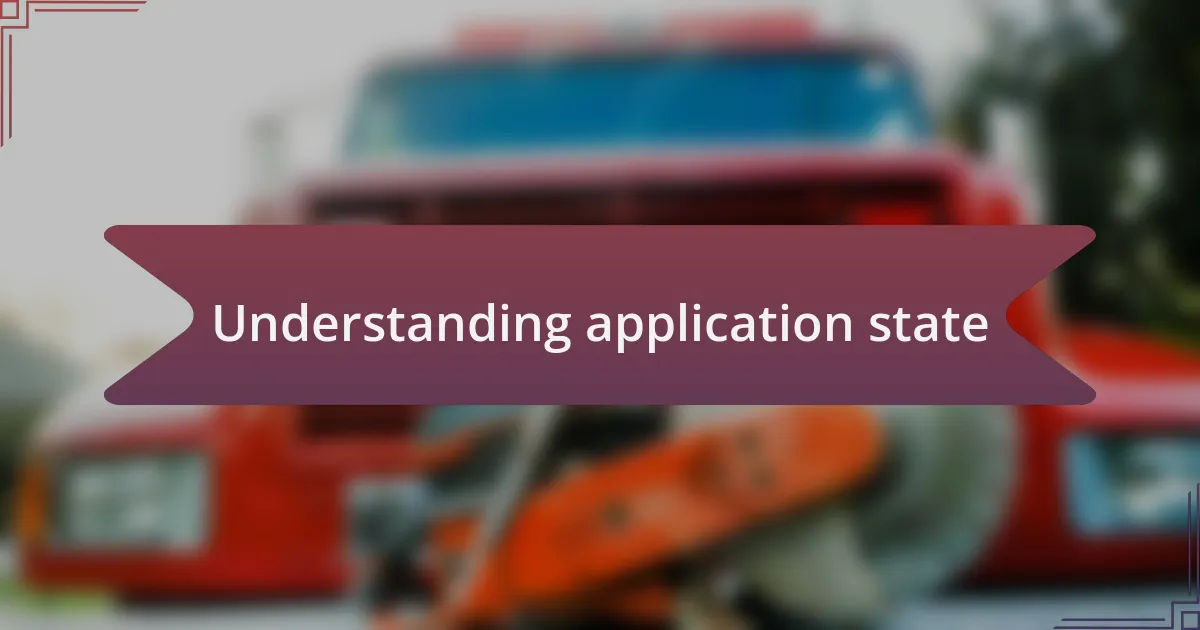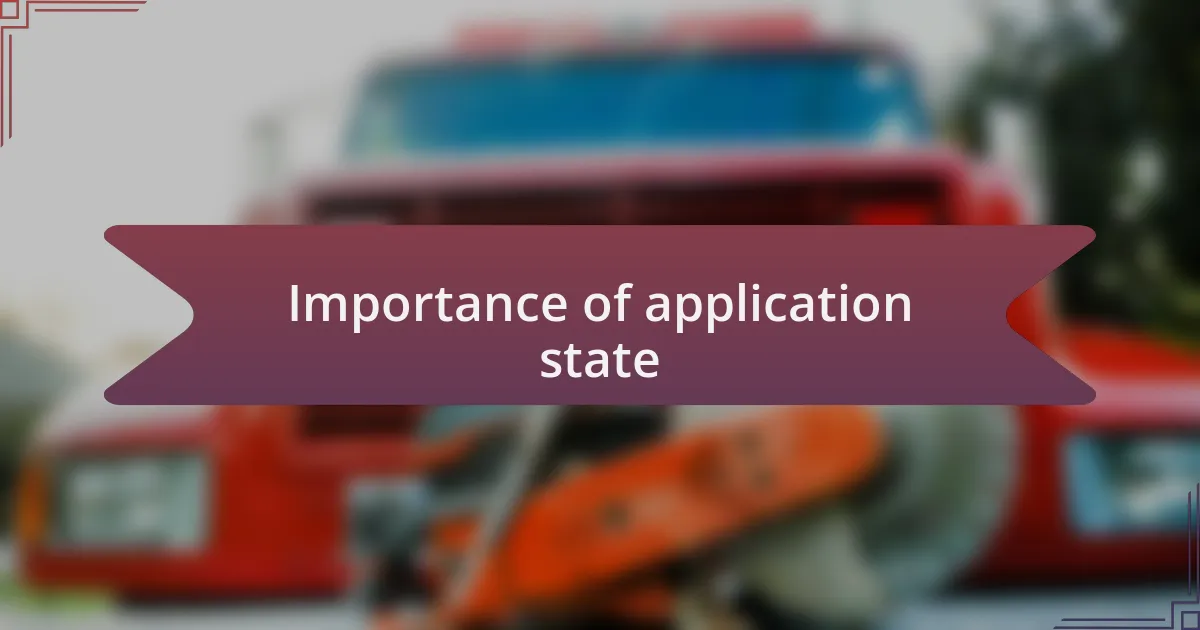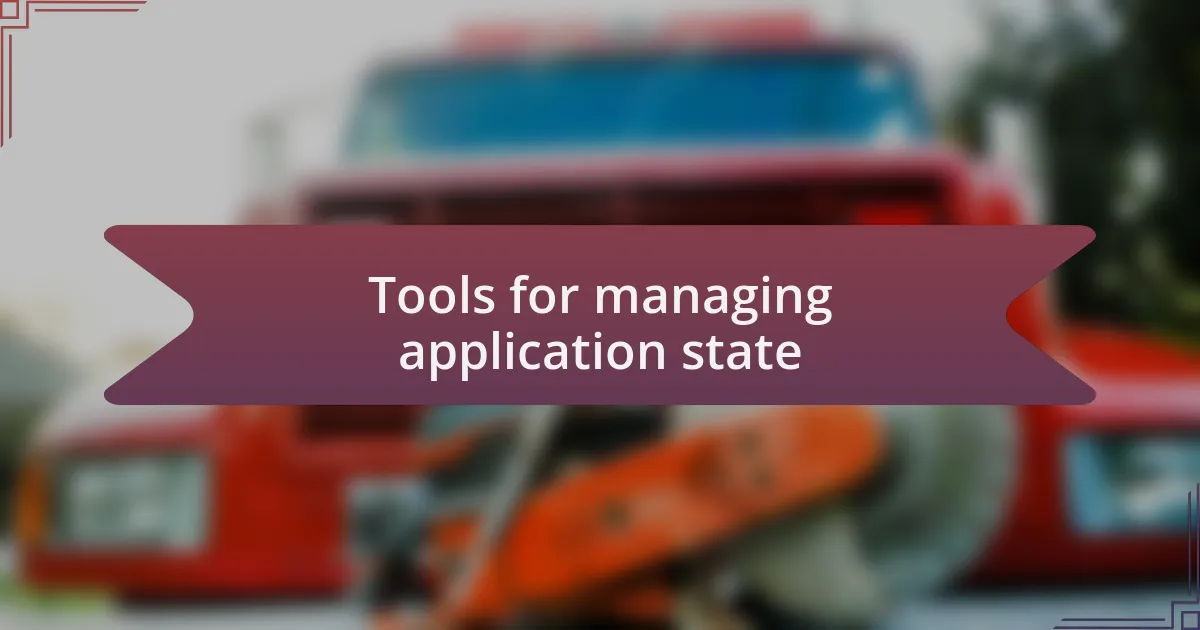Key takeaways:
- Application state is crucial for user experience; well-managed state leads to seamless interactions and user satisfaction.
- Centralized state management tools like Redux simplify debugging and scaling, while context API and Zustand provide lightweight alternatives for simpler applications.
- Regular reassessment of state management strategies and documentation of decisions enhance clarity and team collaboration.
- Effective communication among team members is essential to prevent misalignment and ensure smooth workflows in state management.

Understanding application state
Application state refers to the data that drives the functionality and appearance of a web application at any given moment. I remember a project where users were struggling to keep track of their selections across different parts of the interface. It struck me how crucial a well-managed application state is for a seamless user experience; a little inconsistency can lead to frustration and a loss of trust.
Consider this: without a clear understanding of application state, developers can easily slip into a chaotic mess of data handling. I’ve been there, battling to maintain a sense of order, only to realize that a centralized state management approach simplifies the process. When I moved to using tools like Redux for state management, it felt like I finally gained control over the chaos, making both debugging and scaling much more manageable.
Ultimately, managing application state is about creating a smooth journey for users. I often ask myself if the effort I put into streamlining state is worth it, and every time, I’m reminded of the positive feedback from users who appreciate an intuitive experience. Investing time in understanding and managing this state ultimately pays off, both for developers and users alike.

Importance of application state
Application state plays a vital role in ensuring that users can interact with web applications predictably and efficiently. I once worked on a project where inconsistent state transitions led to user confusion; the moment I realized that users were abandoning tasks due to unexpected behaviors, I understood how critical clear application state is. Have you noticed how a seamless experience can keep users engaged, while a jarring interaction can drive them away?
When application state is well managed, it creates a reliable environment that users trust. I recall a particularly complex application where users frequently updated their profiles. The ability to reflect those changes in real-time without glitches not only delighted them but also reduced the need for support calls. That experience made me appreciate how vital it is to manage state effectively, as it directly influences user satisfaction and retention.
Additionally, a well-organized application state aids developers in maintaining coding efficiency as projects grow. There was a time when I struggled to track multiple pieces of state spread throughout an application, leading to blocked development paths. Since adopting clear state management strategies, I’ve seen how much easier it becomes to add features and resolve bugs. Isn’t it amazing how a structured approach to application state can turn a daunting task into a smoother workflow?

Common challenges in application state
Managing application state presents a variety of challenges that can frustrate both developers and users. One struggle I faced involved the timing of state updates, especially when multiple components depend on the same data. I remember feeling overwhelmed when UI updates lagged behind data changes, leading to a disjointed user experience. Have you ever experienced a delay that made you question whether your actions were even registering?
Another common issue is dealing with asynchronous operations, which can lead to race conditions if not handled carefully. I recall a project where I implemented a feature that required multiple API calls to fetch data. This complexity introduced unexpected bugs, as some calls would complete out of order, resulting in incorrect state updates. It taught me how critical it is to have a robust mechanism for managing these asynchronous flows.
Furthermore, managing global state versus local state creates its own set of headaches. In one instance, I decided to store user preferences at a global level, thinking it would simplify access across various components. But soon, I encountered problems with multiple components trying to update the same state, causing conflicts that left me scratching my head for solutions. How do you strike the right balance between global and localized state to maintain harmony?

Tools for managing application state
When it comes to managing application state, one tool that has significantly shaped my approach is Redux. I remember the first time I integrated Redux into a project; it felt like finding a roadmap in an unfamiliar city. By centralizing the application state, I could easily track changes and debug issues. Have you ever had a moment where the clarity of a tool made all the difference in your development process?
In contrast, I also experimented with React’s built-in context API for less complex applications. Initially, I was hesitant, fearing that I might lose the benefits of a centralized state management system. However, I soon discovered that for small to mid-sized apps, the context API provided a lightweight solution to manage states effectively. It was refreshing to see more straightforward state sharing without the overhead, and it left me pondering how simplifying tools can sometimes yield surprisingly powerful outcomes.
Moreover, I’ve recently explored using Zustand, a minimalistic state management tool. It was fascinating to find a balance between simplicity and functionality. Zustand’s approach to state management amazed me, as it allowed me to create a store with just a few lines of code. Have you ever found a tool that made you rethink your entire workflow? It certainly encouraged me to appreciate the power of efficient coding practices while addressing application state in a clean and manageable way.

My approach to managing state
Managing state in my applications has always been about finding the right balance between complexity and efficiency. In my experience, I often start by analyzing the needs of the project; if it’s straightforward, I lean towards simpler solutions. There was a project where I spent too much time over-engineering state management, only to realize that a few well-placed local states would have sufficed. Have you ever lost sight of the completion goal because of over-complicating matters?
When the application starts to scale, I shift gears and embrace more structured tools like Redux or Zustand. I recall a mid-sized application where breaking the state into slices made a world of difference. Each slice, like a chapter in a book, had its own story, which made understanding the state flow so much clearer. It turns out, compartmentalizing state helped not just in management but also in team collaboration. Have you felt the collaborative spirit ignite when everyone understands their role in the codebase?
Furthermore, I find it essential to regularly reassess my state management strategies as projects evolve. I’ll never forget the moment I integrated the context API into an existing project; it illuminated how shared state could simplify component interactions. I often find myself asking, what’s the simplest way to get from point A to B? Keeping that question at the forefront has made me more agile and responsive to changes, and it’s a mindset I recommend to anyone looking to improve their development workflow.

Lessons learned from my experience
As I’ve navigated various projects, one key lesson stands out: the importance of documenting my state management decisions. Early on, I neglected to keep track of why I chose certain patterns or tools, which led to confusion later in the process. Have you ever found yourself backtracking because you couldn’t remember the thinking behind a choice? When I started jotting down my rationale, not only did it clarify my thought process, but it also served as a valuable reference for teammates jumping onto the project.
I also learned that communication is just as vital as the chosen tools. In a project where my colleague and I implemented a complex state management system, we initially struggled to align our understanding of its structure. That misalignment created a ripple effect of bugs and confusion. Reflecting on that experience, I realized that regular check-ins and open conversations would have saved us time and frustration. Have you considered how much smoother your workflow could be with a simple dialogue?
Another lesson was to embrace experimentation with state management strategies rather than fearing them. While it took me some time to step away from a rigid approach, I found that trying out new methods—like employing local storage for persisting state—often led to unexpected improvements. It was during one of these explorations that I discovered how integrating, say, server state could dramatically enhance user experience. In those moments, I often ask myself, “What do I have to lose by trying something new?” The answer? Quite a bit of innovation and growth.